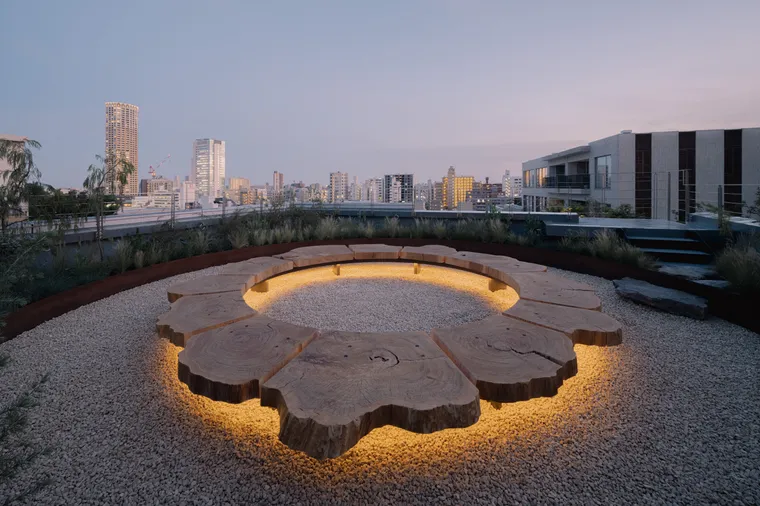Perhaps Tokyo is the planet’s most heightened paradigm for craftsmanship. And thus, it makes perfect sense that the Canadian outdoor cult brand Arc'teryx wanted to add to that elixir. What could be better than a design hub—one called the Tokyo Creation Center (TCC), right here in Japan—for big ideas, plus designing and creating incredible prototypes and new products? Not to mention, it doubles as a fun location where local and visiting diehards can come together to show off their Arc'teryx artifacts.









Photos by Joel Fuller
The Vancouver-based brand’s name comes from “Archaeopteryx Lithographica,” the first reptile to develop feathers for flight and adapt its skills for climbing. So, as Katie Becker, Chief Creative Officer, reiterates to me, for the Arc’teryx team, it’s all about “disruptive evolution and human progress in the outdoors.”
The ultimate goal for TCC is to work with athletes, designers, and the community to make new, long-lasting, and game-changing products—and factoring in Tokyo’s hot weather, those products will include clothing engineered for the local climate. But to get there, the space had to be just right, with elements that appealed to everyone. And thus, Arc'teryx asked Japan-based Torafu Architects to take a four-story building in a Tokyo neighborhood and give it a whole new flair while also showing the coastal mountains of the brand’s DNA.
“Tokyo does not have a natural environment like Vancouver, but from our experience there, when we are incorporating greenery, we thought about how we could experience both Japanese and North American nature,” shares Koichi Suzuno, founder at Torafu Architects. The firm infused it into every level, with forest greens, mountainscapes, stones, wood, and even trees.
The architects also wanted to incorporate Japanese craftsmanship and technology, so they collaborated with an array of supreme artists and craftspeople. “It could be said that we drew inspiration from their skills and used that to evolve the design,” adds Suzuno. “We formed teams with people skilled in woodworking, indigo dyeing, furniture-making, ironworks, landscaping, and more, all the way discussing Arc'teryx while working together to create this.”
And thus, the space is glorious.
Downstairs is a community space with an art piece from Washi artist Wataru Hatano, who based the work on the Kanji character “Yama,” meaning “mountain” in English. One floor up is where the craftspeople and patternmakers sit with machines and giant tables—with a massive wall of memorabilia symbolizing everything Tokyo is about, plus iconic products the brand has made. And as mentioned, providing the outdoorsy and mountainous aesthetic, there is a traditional Japanese garden created by Torafu Architects.
Another floor up is the design level, where athletes meet and brainstorm (plus a conference room space). And on the rooftop is a leafy area with a circular cedar bench from which to observe Mount Fuji on a clear day, or simply to sit and meditate in this big city. Every level is indicative of the care and focus the brand puts into its high-end, best-on-the-market products.









Photos by Joel Fuller
“It's functional, it's beautiful, it's responsible, like it's authentic to Arc'teryx,” Becker says. “Here, we now have an opportunity to take this TCC concept and even look at our retail spaces and how we bring products to life in a new meaningful way that we haven't done in the past.” For them, it's not just “designed in Tokyo.” It's “Made in Tokyo,” and crafted in Tokyo, with the design team and the athletes in the region. And that is the story that Arc’teryx will be telling.
“We don't design products here. I've worked at a lot of different companies: you sketch out a product, you go to a factory, you make it, you bring it back, you tweak it a little. It's not like that here,” says Becker. The brand has always been disruptive and different, and so this Tokyo project was a continuation of exactly that. “I think people were drawn to our uniqueness—almost like non-trend, just love and care in every product we make,” says Becker.
“We have these design filters, and first is it functional and then is it beauty, and that concept of housing function and beauty and like stripping everything off, so you can look at pieces that people covet that are 10 years old, 20 years old, they still look unbelievable,” shares Becker. In fact, these iconic older pieces are what diehard fans still carry with them (and I met a bunch of them right here in Tokyo). And when these items get a bit of wear and tear or have a little damage from being outdoors, the brand has its ReBIRD repair program, through which customers can bring items into the brand’s stores and have them fixed. Nobody wants to throw these products away. So, their story continues.









Photos by Joel Fuller
Howard Lichter, the VP at the Tokyo Design Center, told me that all roads led them to Tokyo. “At some point, as we've become a global brand, we have to get out and just widen the aperture.” And the brand’s very DNA is that of the coastal mountains of British Columbia in Canada. “If a brand wants to grow, to evolve, to learn, they've gotta get out of their point of origin. If you look at the idea of craft, of making, of obsession, of beauty, of function, of resolution—all of those ideas; it was inevitable that we came here to Tokyo,” he says.
And here they are—creating products for the next future.
Arc'teryx Tokyo Creation Center
https://maps.app.goo.gl/iKpYvqpjPo2cP5d38?g_st=iw1-Chome-4-10 Aobadai, Meguro City, Tokyo, 153-0042, Japan







Photos by Joel Fuller


